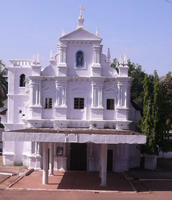Mother of the Poor Church, Nuvem, Goa

History:
The Mother of the Poor Church, Nuvem, Goa is also known as ‘Mae dos Pobres Igreja em Nuvem, Goa’ in Portuguese. Mother of the Poor Church, Nuvem, Goa is popularly called ‘The Nuvem Church’ in Goa. The Mother of the Poor Church, Nuvem was originally a local chapel dedicated to Jesus, Mary and Joseph in 1695. The Chapel was affiliated to the parish of the Holy Spirit Church, Margao. The Nuvem Church became a separate parish in 1903.
The Religious orders found in the Nuvem Parish are congregation of the Religious Men order of Holy Cross CSC, The Religious Women order of Apostolic Carmel AC and Sister Adorers AASC. The Fathers of the Holy Cross are based at Kirbhat, Nuvem. The Apostolic Carmel are based at Carmel Convent, Nuvem and Holy Rosary Convent, Nuvem which the Sisters Adorers are based at Belloy, Nuvem.
The Educational Institutions based in the Nuvem parish are The Carmel College, The Carmel higher Secondary School and The Holy Rosary Convent all run by Apostolic Carmel AC. The School in the Nuvem Parish is the Mae dos Pobres high school.
The Hostel for Girls which is the Carme Hostel and the Holy Rosary Boarding House are both run by Apostolic Carmel.
The Rehabilitation Home of Nava Jyothi Rehabilitation Centre is run by Sister Adorers.
The Number of Catholics in the Nuvem Church are around 10,800.
The feast of the Nuvem Church is celebrated on the first Sunday of November every year.
ARTICLES
The Feast of Mae dos Pobres Church in Nuvem, Goa
Every year on the first Sunday of November, a grand feast is celebrated in the small town of Nuvem, on the outskirts of Margao. Lying of the banks of the river Sal, between verdant paddy fields and surrounded by hillocks, Nuvem has a large population of around 18,000 Catholics who congregate at the church of Jesus, Mary and Joseph.
This Church was built in the first decade of the twentieth century. In 1695, a chapel was built as part of a holiday home of one Bertha Colaco from Margao. It was dedicated to Jesus, Mary and Joseph and was affiliated to the Holy Spirit church in Margao. Every summer the Colaco family would spend time at the holiday home. In fact, a niche where the bones of one of the ancestors was placed still bears mute testimony of this fact, in one of the back rooms of the present day church.
The church was elevated to a new parish and delinked by a provision passed on March 17, 1903. The architectural style used in it is Mannerist, Neo Roman. According to archives, the church consists of 4 large bays and has 3 storeys. The columns in the lower storey are Corinthian zed. The frontispiece has a templet with coupled pilasters with fern edged gable curves. The finials are of the spear and ball types and the large porch is cantilevered on round columns. There is a single tower on the left side of the church from where the bell has toiled for more than a hundred years. During the golden jubilee year of the church, a large imposing monument of Christ the king was put up in the compound.
From early times, the people of Nuvem were traditionally engaged in mining and road building activities. They traveled far and wide throughout Goa where their services were needed. However they always came home to celebrate ‘all souls day’ on November 2 each year when they would pray for their deceased family members in a special way. Legend has it that weary of the hard toil, the people stayed at home for at least a week and on the following Sunday they would feast. They would invite relatives and guests from neighboring villages and prepare elaborate meals. This was perhaps how the feast of Mae dos Pobres started. Mae dos Pobres literally means Mother of the Poor. With great devotion and immense faith in Mother Mary, the simple working class of Nuvem would pray for grace and favors from God.
People gather from far and wide for nine days preceding the feast to take part in the novenas. A huge fair builds up around the church and for a whole week the faithful jostle with the vendors as the sounds of devotional hymns mingle with the cries of the stall owners. The fair, since time immemorial, has been famous for cattle and pottery. The entire area behind the church used to be reserved for the buying and selling of cattle. Today they use only a small strip of land between fields for the same. The sale of earthen pots continues to this day however. Available in various shapes and sizes, the pottery draws many buyers, for the best Goan curry can only be made in an earthen pot on a wooden fire.